University Finance Report: Managing Financial Resources and Decisions
VerifiedAdded on 2020/01/28
|23
|4822
|57
Report
AI Summary
This finance report comprehensively addresses financial resource management, encompassing various key aspects. It begins with the preparation and analysis of a cash budget, crucial for evaluating liquidity. The report then delves into calculating selling prices, profit margins, and the impact of markups on profitability. Investment decisions are analyzed using Net Present Value (NPV) and payback period calculations, offering insights into the viability of different investment options. The report also examines financial statements, including balance sheets and income statements, comparing their formats for different business organizations. Furthermore, it assesses the information needs of various financial statement users and interprets financial data using relevant ratios, such as profitability and gearing ratios. Finally, the report explores diverse sources of finance available to businesses, evaluating their implications and identifying the most appropriate funding options. It also discusses the cost of finance, its impact on financial statements, and the importance of financial planning.
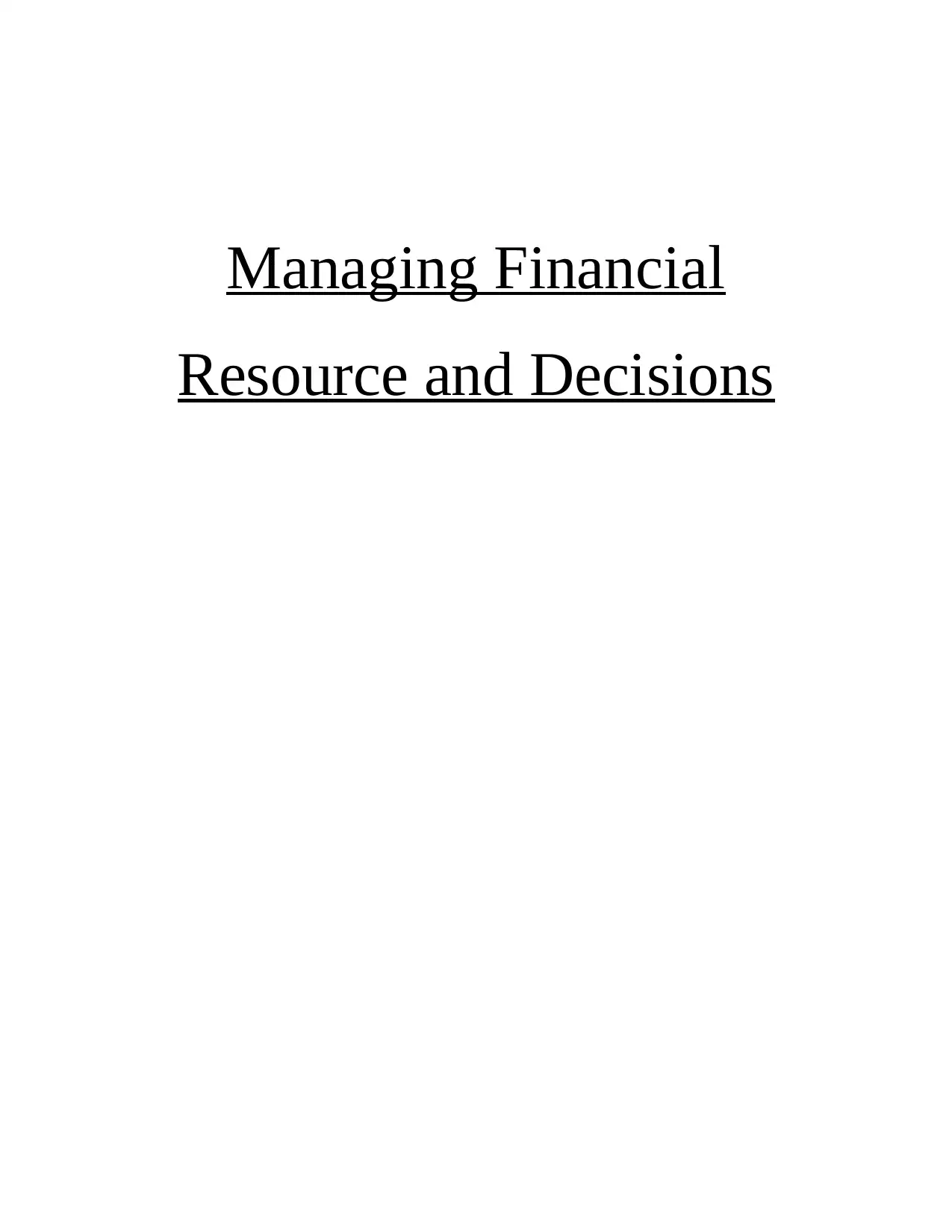
Managing Financial
Resource and Decisions
Resource and Decisions
Paraphrase This Document
Need a fresh take? Get an instant paraphrase of this document with our AI Paraphraser
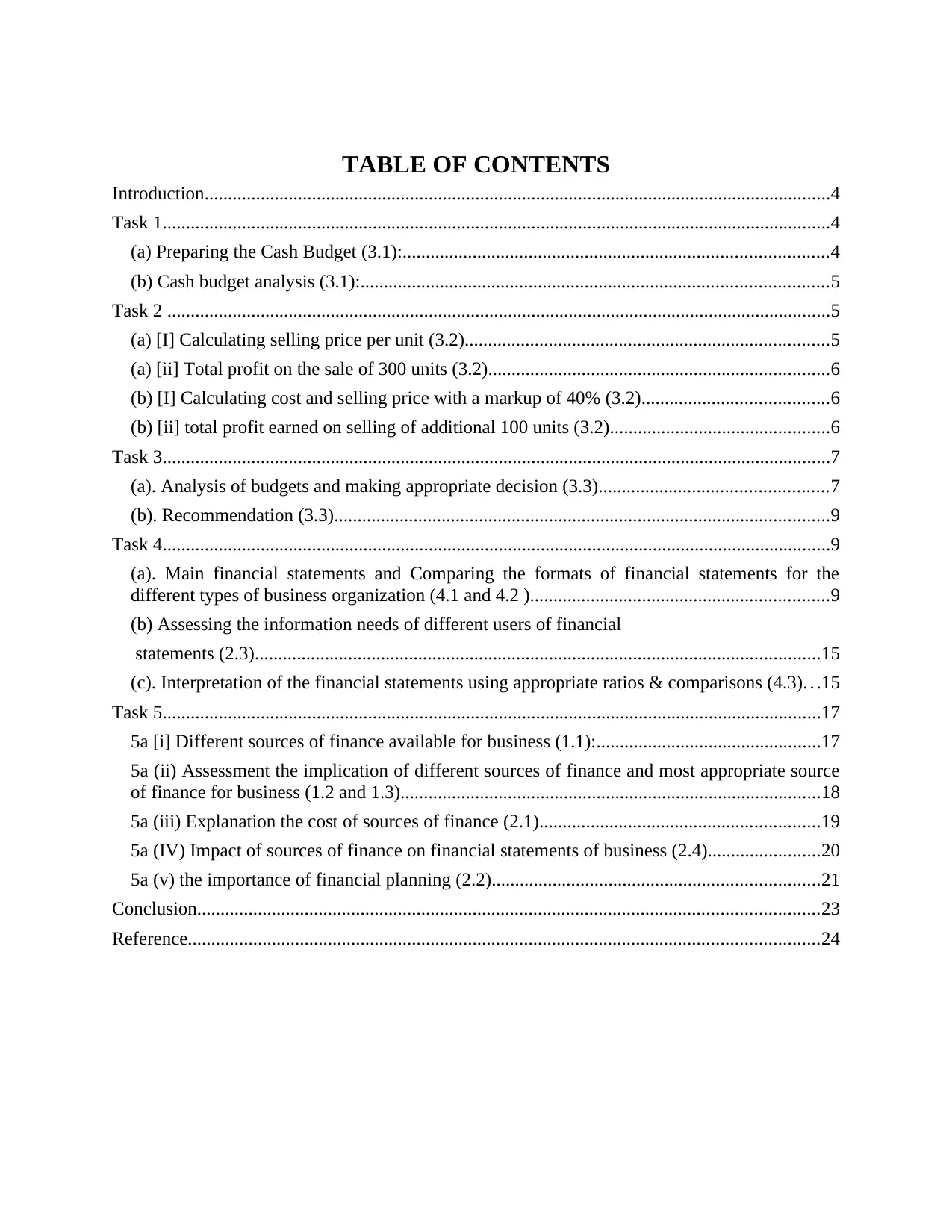
TABLE OF CONTENTS
Introduction......................................................................................................................................4
Task 1...............................................................................................................................................4
(a) Preparing the Cash Budget (3.1):...........................................................................................4
(b) Cash budget analysis (3.1):....................................................................................................5
Task 2 ..............................................................................................................................................5
(a) [I] Calculating selling price per unit (3.2)..............................................................................5
(a) [ii] Total profit on the sale of 300 units (3.2).........................................................................6
(b) [I] Calculating cost and selling price with a markup of 40% (3.2)........................................6
(b) [ii] total profit earned on selling of additional 100 units (3.2)...............................................6
Task 3...............................................................................................................................................7
(a). Analysis of budgets and making appropriate decision (3.3).................................................7
(b). Recommendation (3.3)..........................................................................................................9
Task 4...............................................................................................................................................9
(a). Main financial statements and Comparing the formats of financial statements for the
different types of business organization (4.1 and 4.2 )................................................................9
(b) Assessing the information needs of different users of financial
statements (2.3).........................................................................................................................15
(c). Interpretation of the financial statements using appropriate ratios & comparisons (4.3). . .15
Task 5.............................................................................................................................................17
5a [i] Different sources of finance available for business (1.1):................................................17
5a (ii) Assessment the implication of different sources of finance and most appropriate source
of finance for business (1.2 and 1.3)..........................................................................................18
5a (iii) Explanation the cost of sources of finance (2.1)............................................................19
5a (IV) Impact of sources of finance on financial statements of business (2.4)........................20
5a (v) the importance of financial planning (2.2)......................................................................21
Conclusion.....................................................................................................................................23
Reference.......................................................................................................................................24
Introduction......................................................................................................................................4
Task 1...............................................................................................................................................4
(a) Preparing the Cash Budget (3.1):...........................................................................................4
(b) Cash budget analysis (3.1):....................................................................................................5
Task 2 ..............................................................................................................................................5
(a) [I] Calculating selling price per unit (3.2)..............................................................................5
(a) [ii] Total profit on the sale of 300 units (3.2).........................................................................6
(b) [I] Calculating cost and selling price with a markup of 40% (3.2)........................................6
(b) [ii] total profit earned on selling of additional 100 units (3.2)...............................................6
Task 3...............................................................................................................................................7
(a). Analysis of budgets and making appropriate decision (3.3).................................................7
(b). Recommendation (3.3)..........................................................................................................9
Task 4...............................................................................................................................................9
(a). Main financial statements and Comparing the formats of financial statements for the
different types of business organization (4.1 and 4.2 )................................................................9
(b) Assessing the information needs of different users of financial
statements (2.3).........................................................................................................................15
(c). Interpretation of the financial statements using appropriate ratios & comparisons (4.3). . .15
Task 5.............................................................................................................................................17
5a [i] Different sources of finance available for business (1.1):................................................17
5a (ii) Assessment the implication of different sources of finance and most appropriate source
of finance for business (1.2 and 1.3)..........................................................................................18
5a (iii) Explanation the cost of sources of finance (2.1)............................................................19
5a (IV) Impact of sources of finance on financial statements of business (2.4)........................20
5a (v) the importance of financial planning (2.2)......................................................................21
Conclusion.....................................................................................................................................23
Reference.......................................................................................................................................24
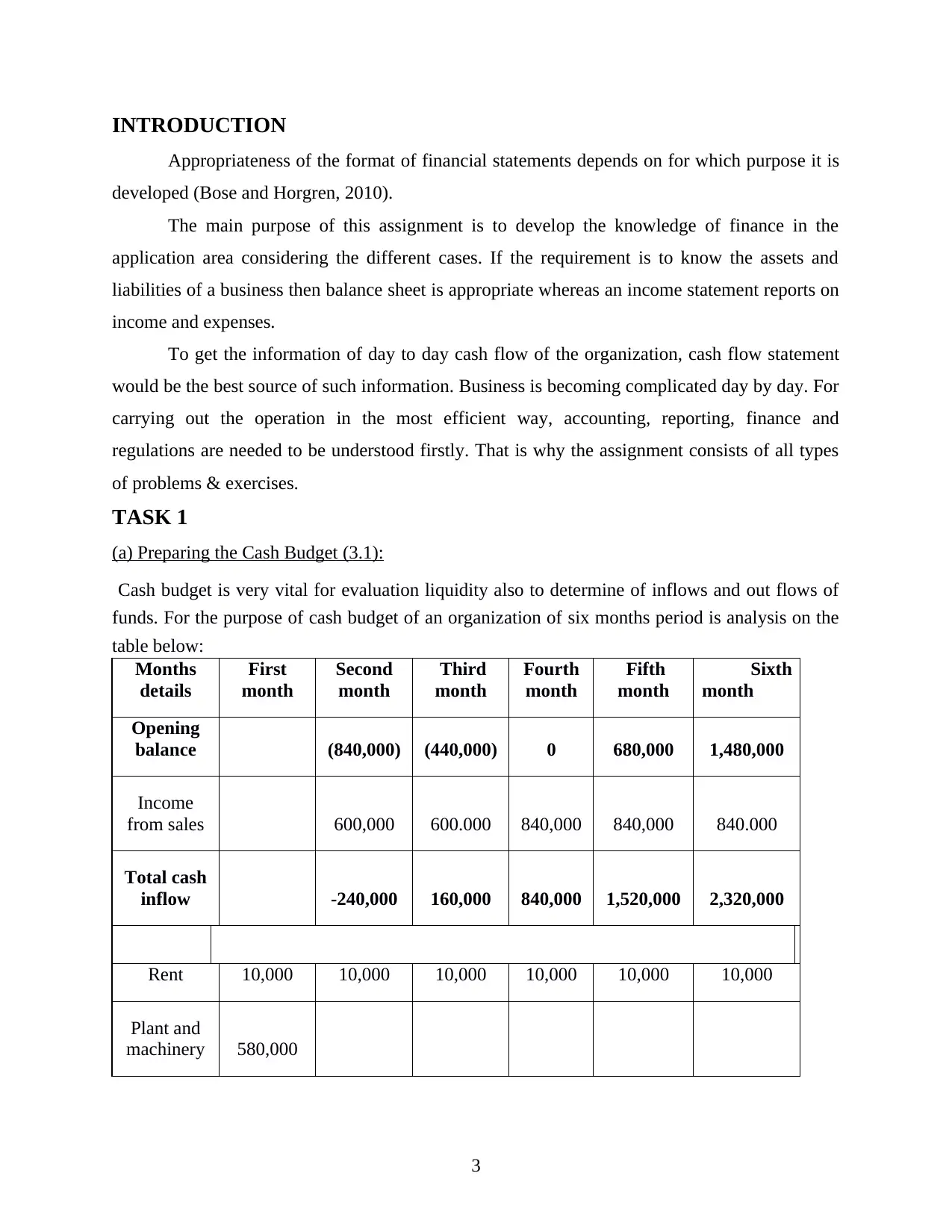
INTRODUCTION
Appropriateness of the format of financial statements depends on for which purpose it is
developed (Bose and Horgren, 2010).
The main purpose of this assignment is to develop the knowledge of finance in the
application area considering the different cases. If the requirement is to know the assets and
liabilities of a business then balance sheet is appropriate whereas an income statement reports on
income and expenses.
To get the information of day to day cash flow of the organization, cash flow statement
would be the best source of such information. Business is becoming complicated day by day. For
carrying out the operation in the most efficient way, accounting, reporting, finance and
regulations are needed to be understood firstly. That is why the assignment consists of all types
of problems & exercises.
TASK 1
(a) Preparing the Cash Budget (3.1):
Cash budget is very vital for evaluation liquidity also to determine of inflows and out flows of
funds. For the purpose of cash budget of an organization of six months period is analysis on the
table below:
Months
details
First
month
Second
month
Third
month
Fourth
month
Fifth
month
Sixth
month
Opening
balance (840,000) (440,000) 0 680,000 1,480,000
Income
from sales 600,000 600.000 840,000 840,000 840.000
Total cash
inflow -240,000 160,000 840,000 1,520,000 2,320,000
Rent 10,000 10,000 10,000 10,000 10,000 10,000
Plant and
machinery 580,000
3
Appropriateness of the format of financial statements depends on for which purpose it is
developed (Bose and Horgren, 2010).
The main purpose of this assignment is to develop the knowledge of finance in the
application area considering the different cases. If the requirement is to know the assets and
liabilities of a business then balance sheet is appropriate whereas an income statement reports on
income and expenses.
To get the information of day to day cash flow of the organization, cash flow statement
would be the best source of such information. Business is becoming complicated day by day. For
carrying out the operation in the most efficient way, accounting, reporting, finance and
regulations are needed to be understood firstly. That is why the assignment consists of all types
of problems & exercises.
TASK 1
(a) Preparing the Cash Budget (3.1):
Cash budget is very vital for evaluation liquidity also to determine of inflows and out flows of
funds. For the purpose of cash budget of an organization of six months period is analysis on the
table below:
Months
details
First
month
Second
month
Third
month
Fourth
month
Fifth
month
Sixth
month
Opening
balance (840,000) (440,000) 0 680,000 1,480,000
Income
from sales 600,000 600.000 840,000 840,000 840.000
Total cash
inflow -240,000 160,000 840,000 1,520,000 2,320,000
Rent 10,000 10,000 10,000 10,000 10,000 10,000
Plant and
machinery 580,000
3
⊘ This is a preview!⊘
Do you want full access?
Subscribe today to unlock all pages.

Trusted by 1+ million students worldwide

Initial
investment 250,000 160,000 120,000 120,000
Operating
cost 30,000 30,000 30,000 30,000 30,000
Total of
cash
outflow 840,000 200,000 160,000 160,000 40,000 40,000
Cash
balance at
end (840,000) (440,000) 0 680,000 1,480.000 2,280,000
(b) Cash budget analysis (3.1):
From the above cash budget so far has prepared based on the forecast information given,
it can be easily derived that there will always be cash deficit in the 1st 6 (Six) months. It is a very
alarming situation. The manager who is responsible for this cost allocation, budgeting and
forecasting, should prepare another forecast which will definitely have a huge amount to be
concerned in receipts. Another problem may be the opening balance being absent. I hope logical
projections will be made with corrections.
TASK 2
(a) [I] calculating selling price per unit (3.2)
Given that,
Variable cost per unit £ 40
Fixed cost per unit 20
Total per unit cost £ 60
(+) Markup 40% 24
Selling price per unit £ 84
4
investment 250,000 160,000 120,000 120,000
Operating
cost 30,000 30,000 30,000 30,000 30,000
Total of
cash
outflow 840,000 200,000 160,000 160,000 40,000 40,000
Cash
balance at
end (840,000) (440,000) 0 680,000 1,480.000 2,280,000
(b) Cash budget analysis (3.1):
From the above cash budget so far has prepared based on the forecast information given,
it can be easily derived that there will always be cash deficit in the 1st 6 (Six) months. It is a very
alarming situation. The manager who is responsible for this cost allocation, budgeting and
forecasting, should prepare another forecast which will definitely have a huge amount to be
concerned in receipts. Another problem may be the opening balance being absent. I hope logical
projections will be made with corrections.
TASK 2
(a) [I] calculating selling price per unit (3.2)
Given that,
Variable cost per unit £ 40
Fixed cost per unit 20
Total per unit cost £ 60
(+) Markup 40% 24
Selling price per unit £ 84
4
Paraphrase This Document
Need a fresh take? Get an instant paraphrase of this document with our AI Paraphraser
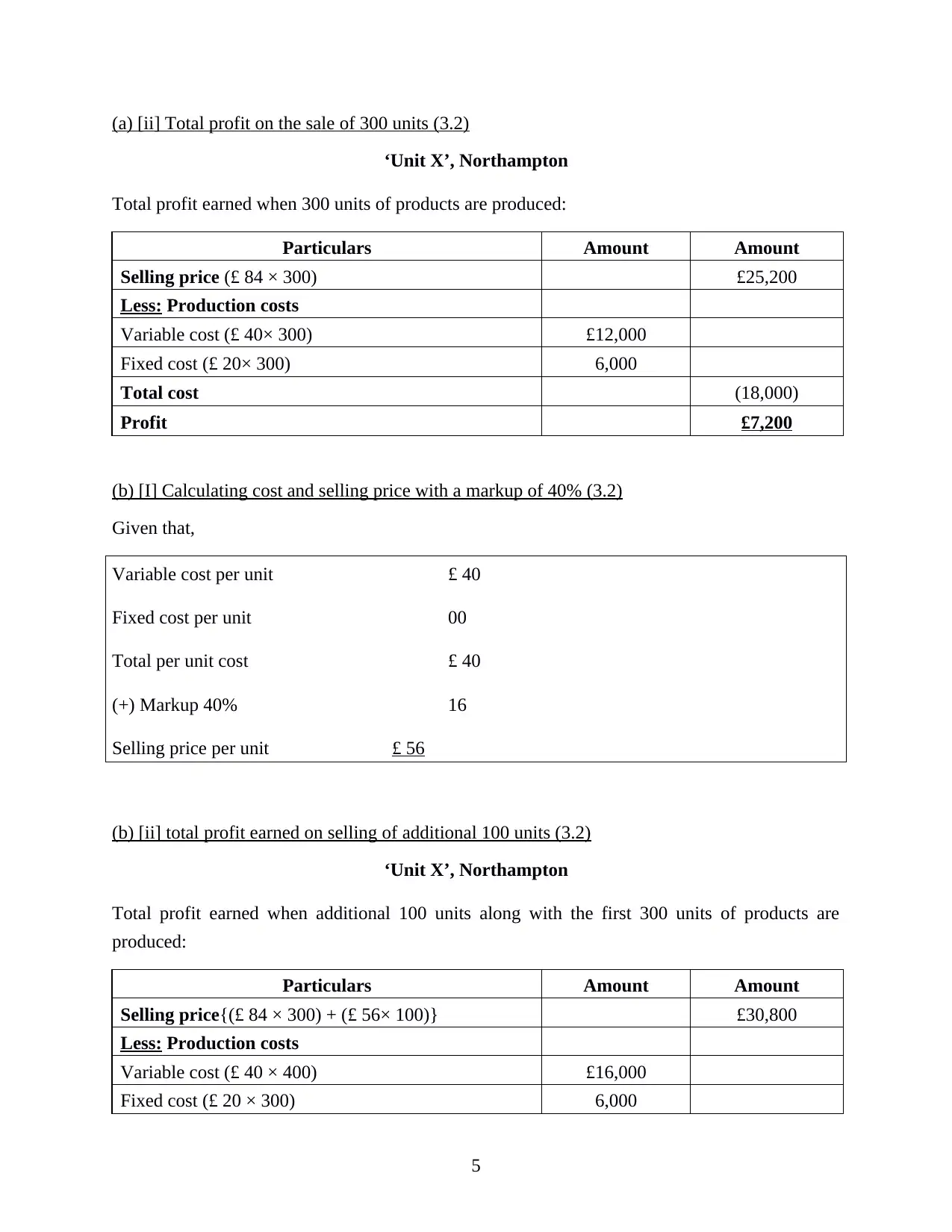
(a) [ii] Total profit on the sale of 300 units (3.2)
‘Unit X’, Northampton
Total profit earned when 300 units of products are produced:
Particulars Amount Amount
Selling price (£ 84 × 300) £25,200
Less: Production costs
Variable cost (£ 40× 300) £12,000
Fixed cost (£ 20× 300) 6,000
Total cost (18,000)
Profit £7,200
(b) [I] Calculating cost and selling price with a markup of 40% (3.2)
Given that,
Variable cost per unit £ 40
Fixed cost per unit 00
Total per unit cost £ 40
(+) Markup 40% 16
Selling price per unit £ 56
(b) [ii] total profit earned on selling of additional 100 units (3.2)
‘Unit X’, Northampton
Total profit earned when additional 100 units along with the first 300 units of products are
produced:
Particulars Amount Amount
Selling price{(£ 84 × 300) + (£ 56× 100)} £30,800
Less: Production costs
Variable cost (£ 40 × 400) £16,000
Fixed cost (£ 20 × 300) 6,000
5
‘Unit X’, Northampton
Total profit earned when 300 units of products are produced:
Particulars Amount Amount
Selling price (£ 84 × 300) £25,200
Less: Production costs
Variable cost (£ 40× 300) £12,000
Fixed cost (£ 20× 300) 6,000
Total cost (18,000)
Profit £7,200
(b) [I] Calculating cost and selling price with a markup of 40% (3.2)
Given that,
Variable cost per unit £ 40
Fixed cost per unit 00
Total per unit cost £ 40
(+) Markup 40% 16
Selling price per unit £ 56
(b) [ii] total profit earned on selling of additional 100 units (3.2)
‘Unit X’, Northampton
Total profit earned when additional 100 units along with the first 300 units of products are
produced:
Particulars Amount Amount
Selling price{(£ 84 × 300) + (£ 56× 100)} £30,800
Less: Production costs
Variable cost (£ 40 × 400) £16,000
Fixed cost (£ 20 × 300) 6,000
5

Total cost (22,000)
Profit £8,800
TASK 3
(a). Analysis of budgets and making appropriate decision (3.3)
Net present value calculations: Is effective way for processing investment assessment for
approximate of cash inflows and outflows at a reduced price as regard to inflation rate of the
economy so that money value technique can be measures in order to evaluate current value of
future cash flow (Drake and Fabozzi, 2012). .
Formula-
NPV = R ×, 1 − (1 + i)-n, − Initial Investment.
Table 2: NPV Investment for A
Yr Cash Inflow for
Option A (£) (R) D.F at 12%
(one) Present
Value(£)
1st yr 24,000 0.892 21,408
2rd yr 24,000 0.797 19,128
3rd yr 24,000 0.711 17,064
4th yr 24,000 0.6355 15,252
The Total of Present
Value 72,852
Less: Initial Investment 75,000
N/P/ Value -2,148
Table 3: NPV Investment for option B
Yr Cash Inflow for
Option B(£) D.F at 12% Present
Value(£)
1st yr 25,000 0.892 22,300
2nd yr 25,000 0.797 19,925
3rd yr 25,000 0.711 17,775
4th yr 25,000 0.6355 15,887.5
The total of Present Value 75,887.5
Less: Initial Investment 80,000
N/P/ Value -4,112.5
Table 4: NPV Investment for option C
Yr Cash Inflow for
Option C (£) D.F at 12% Present
Value(£)
1st Yr 36,000 0.892 32,112
6
Profit £8,800
TASK 3
(a). Analysis of budgets and making appropriate decision (3.3)
Net present value calculations: Is effective way for processing investment assessment for
approximate of cash inflows and outflows at a reduced price as regard to inflation rate of the
economy so that money value technique can be measures in order to evaluate current value of
future cash flow (Drake and Fabozzi, 2012). .
Formula-
NPV = R ×, 1 − (1 + i)-n, − Initial Investment.
Table 2: NPV Investment for A
Yr Cash Inflow for
Option A (£) (R) D.F at 12%
(one) Present
Value(£)
1st yr 24,000 0.892 21,408
2rd yr 24,000 0.797 19,128
3rd yr 24,000 0.711 17,064
4th yr 24,000 0.6355 15,252
The Total of Present
Value 72,852
Less: Initial Investment 75,000
N/P/ Value -2,148
Table 3: NPV Investment for option B
Yr Cash Inflow for
Option B(£) D.F at 12% Present
Value(£)
1st yr 25,000 0.892 22,300
2nd yr 25,000 0.797 19,925
3rd yr 25,000 0.711 17,775
4th yr 25,000 0.6355 15,887.5
The total of Present Value 75,887.5
Less: Initial Investment 80,000
N/P/ Value -4,112.5
Table 4: NPV Investment for option C
Yr Cash Inflow for
Option C (£) D.F at 12% Present
Value(£)
1st Yr 36,000 0.892 32,112
6
⊘ This is a preview!⊘
Do you want full access?
Subscribe today to unlock all pages.

Trusted by 1+ million students worldwide

2nd Yr 36,000 0.797 28,692
3rd Yr 36,000 0.711 25,596
4th Yr 36,000 0.6355 22,878
Total of Present Value 109,278
Less: Initial Investment 95,000
N/P/Value 14,278
Payback period calculation: This process is to determine the time as regard the full amount of
investment will be recovered (Barth, 2006). For this reason, management can estimate
performances of various kinds of projects or investment plan for the organization and chose the
best option to recover the total amount invested in a short period of time.
P/B period = a + B/C
Number of years in which total inflow is less then initial investment for option A
The amount of cash inflow which belongs to same group cumulative cash flow that is similar but
less than initial investment for potion B
Total cumulative cash inflow for option C
P/B period = A+B/C
(b)Table 5: Calculation for P/B period
Yr
Cash
Inflow of
Option A
(£)
Cumulativ
e cash
inflow
Cash
Inflow of
Option B
(£)
Cumulativ
e cash
inflow
Cash
Inflow of
Option C
(£)
Cumul
ative
cash
inflow
1st Yr 24,000 24,000 25,000 25,000
36,000 36,000
2nd Yr 24,000 48,000 25,000 50,000
36,000 72,000
3rd Yr 24,000 72,000 25,000 75,000
36,000 108,000
4th Yr 24,000 96,000 25,000 100,000
36,000 144,000
Initial
Investment 75,000 80,000
100,000
P/b period
3.25 yr 3.25 yr 2.37 yr
7
3rd Yr 36,000 0.711 25,596
4th Yr 36,000 0.6355 22,878
Total of Present Value 109,278
Less: Initial Investment 95,000
N/P/Value 14,278
Payback period calculation: This process is to determine the time as regard the full amount of
investment will be recovered (Barth, 2006). For this reason, management can estimate
performances of various kinds of projects or investment plan for the organization and chose the
best option to recover the total amount invested in a short period of time.
P/B period = a + B/C
Number of years in which total inflow is less then initial investment for option A
The amount of cash inflow which belongs to same group cumulative cash flow that is similar but
less than initial investment for potion B
Total cumulative cash inflow for option C
P/B period = A+B/C
(b)Table 5: Calculation for P/B period
Yr
Cash
Inflow of
Option A
(£)
Cumulativ
e cash
inflow
Cash
Inflow of
Option B
(£)
Cumulativ
e cash
inflow
Cash
Inflow of
Option C
(£)
Cumul
ative
cash
inflow
1st Yr 24,000 24,000 25,000 25,000
36,000 36,000
2nd Yr 24,000 48,000 25,000 50,000
36,000 72,000
3rd Yr 24,000 72,000 25,000 75,000
36,000 108,000
4th Yr 24,000 96,000 25,000 100,000
36,000 144,000
Initial
Investment 75,000 80,000
100,000
P/b period
3.25 yr 3.25 yr 2.37 yr
7
Paraphrase This Document
Need a fresh take? Get an instant paraphrase of this document with our AI Paraphraser
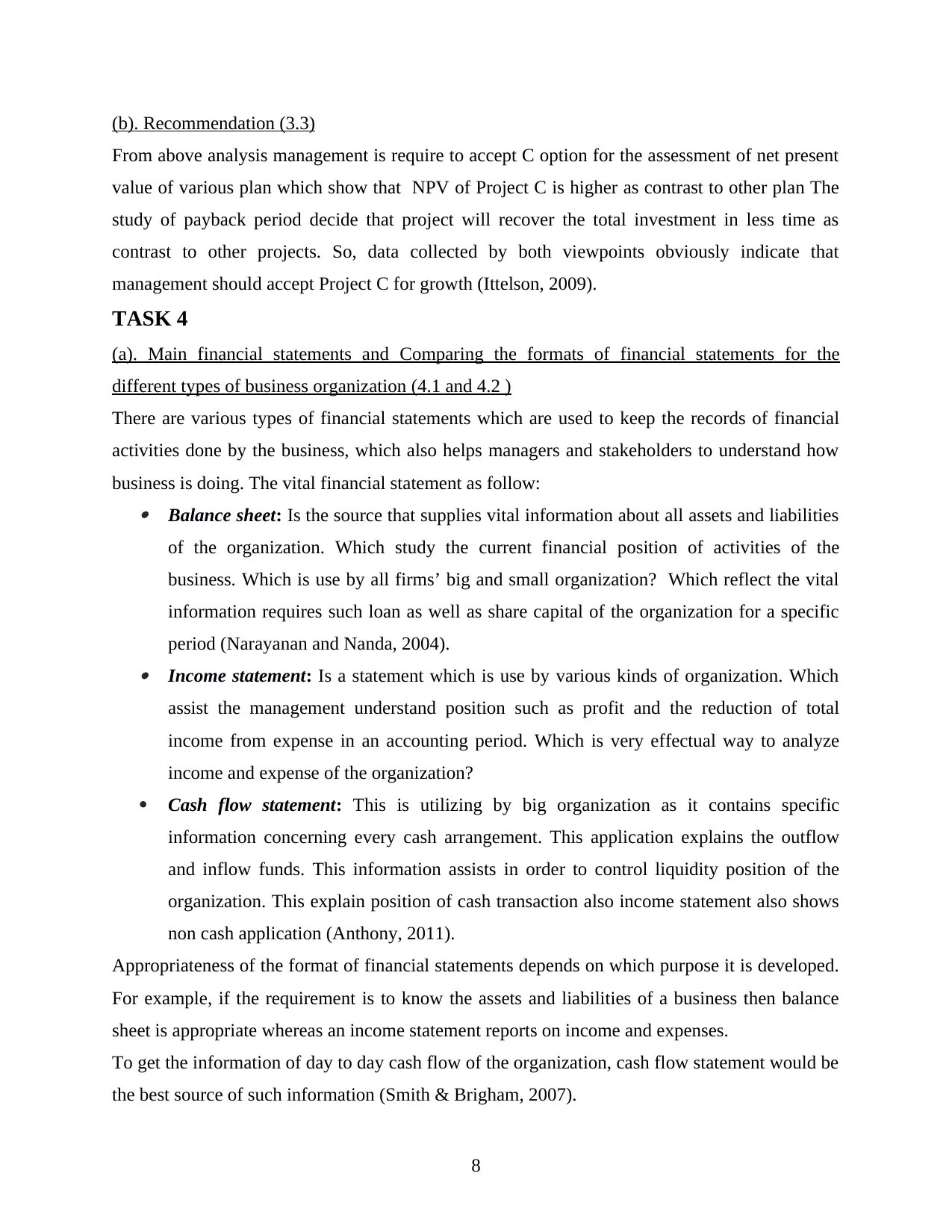
(b). Recommendation (3.3)
From above analysis management is require to accept C option for the assessment of net present
value of various plan which show that NPV of Project C is higher as contrast to other plan The
study of payback period decide that project will recover the total investment in less time as
contrast to other projects. So, data collected by both viewpoints obviously indicate that
management should accept Project C for growth (Ittelson, 2009).
TASK 4
(a). Main financial statements and Comparing the formats of financial statements for the
different types of business organization (4.1 and 4.2 )
There are various types of financial statements which are used to keep the records of financial
activities done by the business, which also helps managers and stakeholders to understand how
business is doing. The vital financial statement as follow: Balance sheet: Is the source that supplies vital information about all assets and liabilities
of the organization. Which study the current financial position of activities of the
business. Which is use by all firms’ big and small organization? Which reflect the vital
information requires such loan as well as share capital of the organization for a specific
period (Narayanan and Nanda, 2004). Income statement: Is a statement which is use by various kinds of organization. Which
assist the management understand position such as profit and the reduction of total
income from expense in an accounting period. Which is very effectual way to analyze
income and expense of the organization?
Cash flow statement: This is utilizing by big organization as it contains specific
information concerning every cash arrangement. This application explains the outflow
and inflow funds. This information assists in order to control liquidity position of the
organization. This explain position of cash transaction also income statement also shows
non cash application (Anthony, 2011).
Appropriateness of the format of financial statements depends on which purpose it is developed.
For example, if the requirement is to know the assets and liabilities of a business then balance
sheet is appropriate whereas an income statement reports on income and expenses.
To get the information of day to day cash flow of the organization, cash flow statement would be
the best source of such information (Smith & Brigham, 2007).
8
From above analysis management is require to accept C option for the assessment of net present
value of various plan which show that NPV of Project C is higher as contrast to other plan The
study of payback period decide that project will recover the total investment in less time as
contrast to other projects. So, data collected by both viewpoints obviously indicate that
management should accept Project C for growth (Ittelson, 2009).
TASK 4
(a). Main financial statements and Comparing the formats of financial statements for the
different types of business organization (4.1 and 4.2 )
There are various types of financial statements which are used to keep the records of financial
activities done by the business, which also helps managers and stakeholders to understand how
business is doing. The vital financial statement as follow: Balance sheet: Is the source that supplies vital information about all assets and liabilities
of the organization. Which study the current financial position of activities of the
business. Which is use by all firms’ big and small organization? Which reflect the vital
information requires such loan as well as share capital of the organization for a specific
period (Narayanan and Nanda, 2004). Income statement: Is a statement which is use by various kinds of organization. Which
assist the management understand position such as profit and the reduction of total
income from expense in an accounting period. Which is very effectual way to analyze
income and expense of the organization?
Cash flow statement: This is utilizing by big organization as it contains specific
information concerning every cash arrangement. This application explains the outflow
and inflow funds. This information assists in order to control liquidity position of the
organization. This explain position of cash transaction also income statement also shows
non cash application (Anthony, 2011).
Appropriateness of the format of financial statements depends on which purpose it is developed.
For example, if the requirement is to know the assets and liabilities of a business then balance
sheet is appropriate whereas an income statement reports on income and expenses.
To get the information of day to day cash flow of the organization, cash flow statement would be
the best source of such information (Smith & Brigham, 2007).
8

The main purpose of the financial statement is to represent financial information regarding
financial position, performance and changes in financial position of a business organization in
front of a wide range of users so that they can take the appropriate decision in future for the
betterment of that organization (Smith & Brigham, 2007). On the other hand, statement of retain
earnings helps to determine the equity issues more specifically.
Comparing the formats of financial statements for the different types of business organization
Sole trader: In this type of businesses only one person controls and manages different
business operation. The size of organization is also very small so as owner of business
develops financial statement in order to keep normal records of business transaction in
the form of income statement with reference to single entry system of accounting for
finding out profit, position and other relevant information.
9
Illustration 1: Balance sheet for sole trader
CHANGE THIS REDO
financial position, performance and changes in financial position of a business organization in
front of a wide range of users so that they can take the appropriate decision in future for the
betterment of that organization (Smith & Brigham, 2007). On the other hand, statement of retain
earnings helps to determine the equity issues more specifically.
Comparing the formats of financial statements for the different types of business organization
Sole trader: In this type of businesses only one person controls and manages different
business operation. The size of organization is also very small so as owner of business
develops financial statement in order to keep normal records of business transaction in
the form of income statement with reference to single entry system of accounting for
finding out profit, position and other relevant information.
9
Illustration 1: Balance sheet for sole trader
CHANGE THIS REDO
⊘ This is a preview!⊘
Do you want full access?
Subscribe today to unlock all pages.

Trusted by 1+ million students worldwide
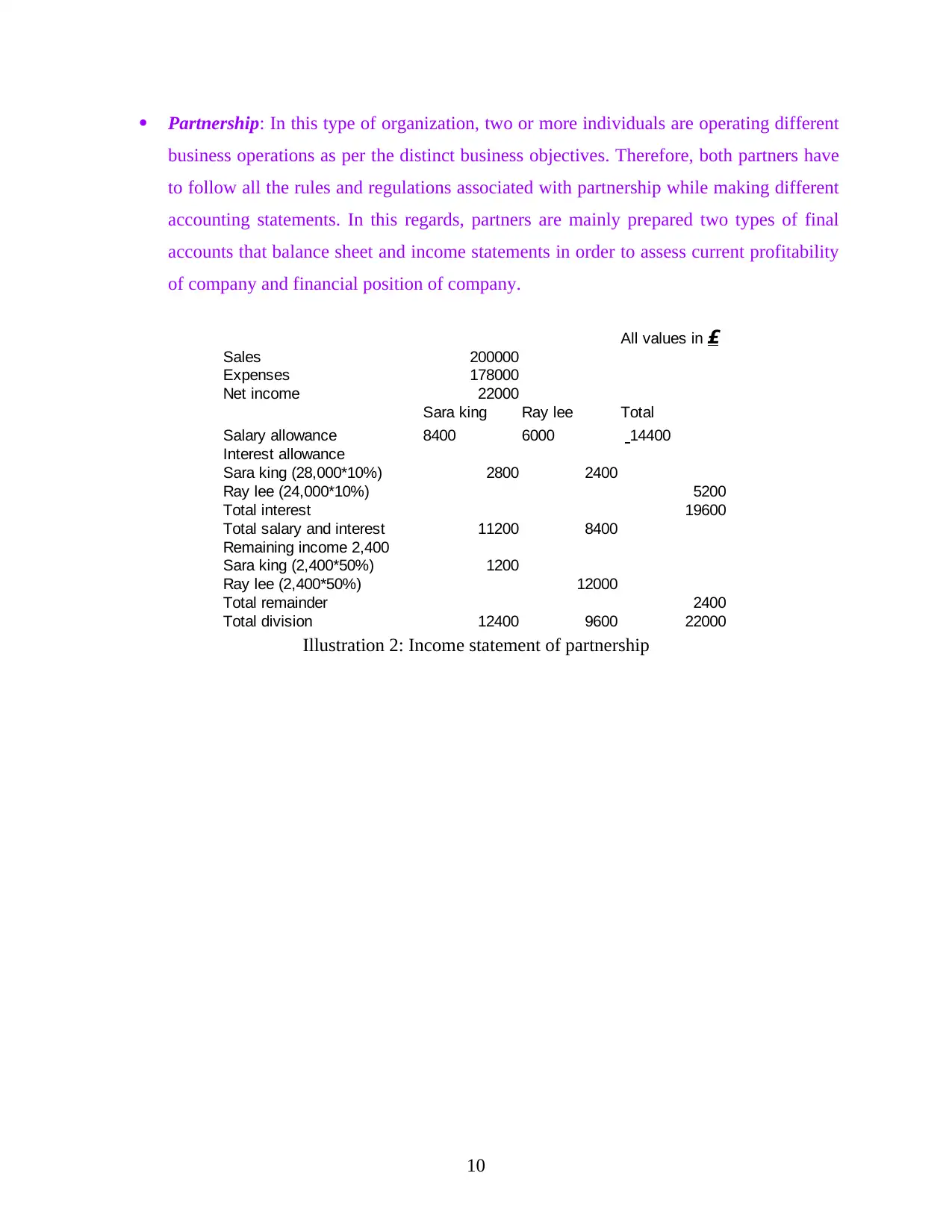
Partnership: In this type of organization, two or more individuals are operating different
business operations as per the distinct business objectives. Therefore, both partners have
to follow all the rules and regulations associated with partnership while making different
accounting statements. In this regards, partners are mainly prepared two types of final
accounts that balance sheet and income statements in order to assess current profitability
of company and financial position of company.
10
Sales 200000
Expenses 178000
Net income 22000
Sara king Ray lee Total
Salary allowance 8400 6000
Interest allowance
Sara king (28,000*10%) 2800 2400
Ray lee (24,000*10%) 5200
Total interest 19600
Total salary and interest 11200 8400
Remaining income 2,400
Sara king (2,400*50%) 1200
Ray lee (2,400*50%) 12000
Total remainder 2400
Total division 12400 9600 22000
All values in £
14400
Illustration 2: Income statement of partnership
business operations as per the distinct business objectives. Therefore, both partners have
to follow all the rules and regulations associated with partnership while making different
accounting statements. In this regards, partners are mainly prepared two types of final
accounts that balance sheet and income statements in order to assess current profitability
of company and financial position of company.
10
Sales 200000
Expenses 178000
Net income 22000
Sara king Ray lee Total
Salary allowance 8400 6000
Interest allowance
Sara king (28,000*10%) 2800 2400
Ray lee (24,000*10%) 5200
Total interest 19600
Total salary and interest 11200 8400
Remaining income 2,400
Sara king (2,400*50%) 1200
Ray lee (2,400*50%) 12000
Total remainder 2400
Total division 12400 9600 22000
All values in £
14400
Illustration 2: Income statement of partnership
Paraphrase This Document
Need a fresh take? Get an instant paraphrase of this document with our AI Paraphraser
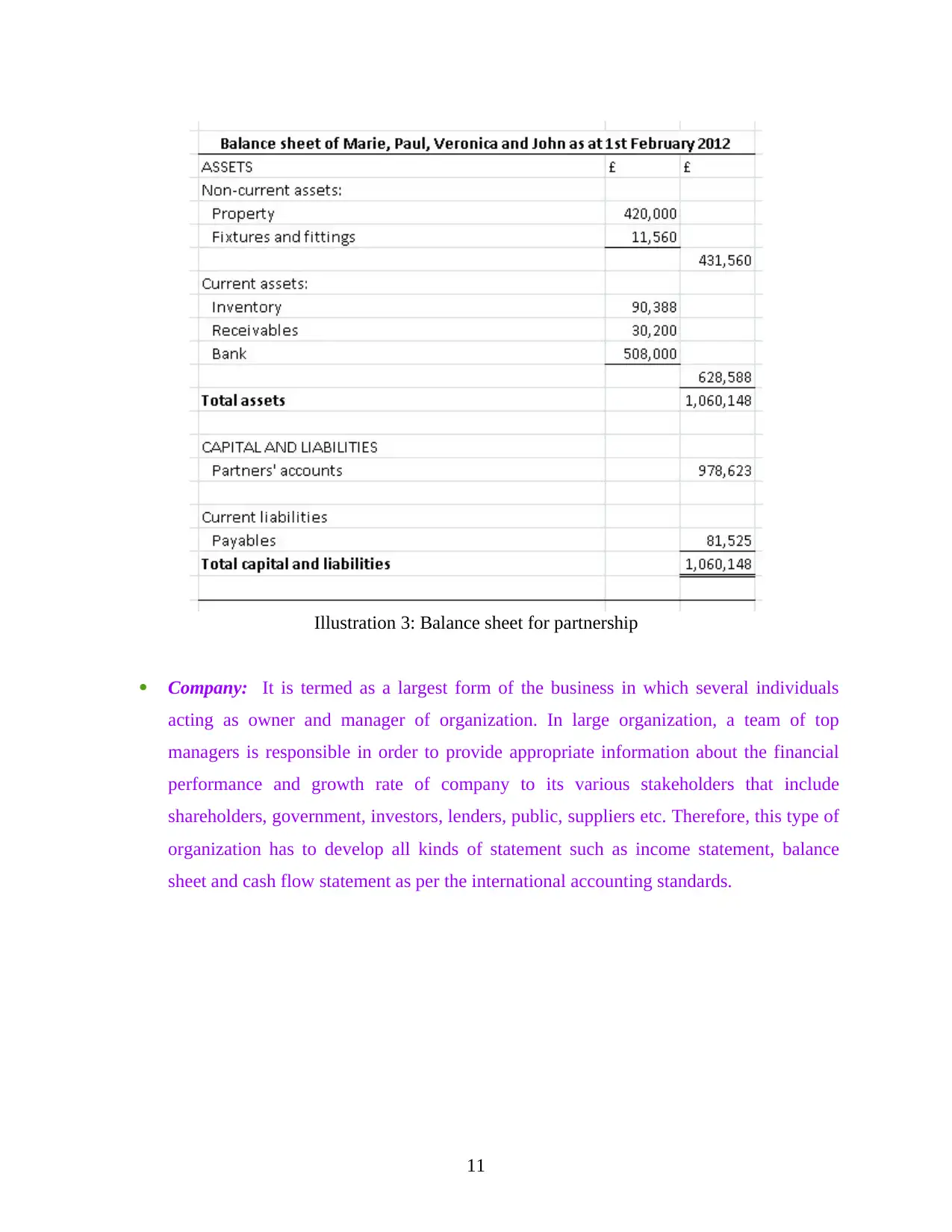
Company: It is termed as a largest form of the business in which several individuals
acting as owner and manager of organization. In large organization, a team of top
managers is responsible in order to provide appropriate information about the financial
performance and growth rate of company to its various stakeholders that include
shareholders, government, investors, lenders, public, suppliers etc. Therefore, this type of
organization has to develop all kinds of statement such as income statement, balance
sheet and cash flow statement as per the international accounting standards.
11
Illustration 3: Balance sheet for partnership
acting as owner and manager of organization. In large organization, a team of top
managers is responsible in order to provide appropriate information about the financial
performance and growth rate of company to its various stakeholders that include
shareholders, government, investors, lenders, public, suppliers etc. Therefore, this type of
organization has to develop all kinds of statement such as income statement, balance
sheet and cash flow statement as per the international accounting standards.
11
Illustration 3: Balance sheet for partnership
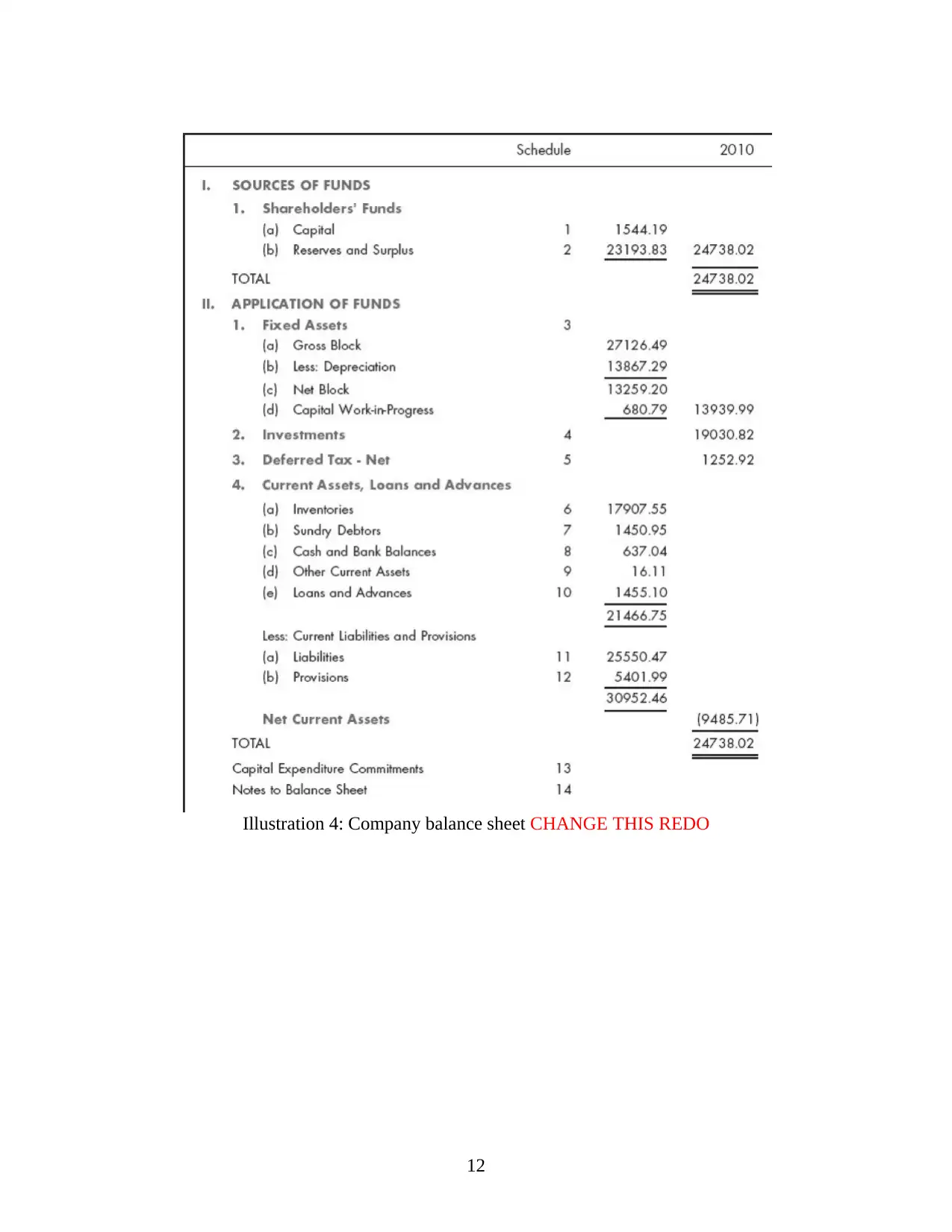
12
Illustration 4: Company balance sheet CHANGE THIS REDO
Illustration 4: Company balance sheet CHANGE THIS REDO
⊘ This is a preview!⊘
Do you want full access?
Subscribe today to unlock all pages.

Trusted by 1+ million students worldwide
1 out of 23
Related Documents
Your All-in-One AI-Powered Toolkit for Academic Success.
+13062052269
info@desklib.com
Available 24*7 on WhatsApp / Email
![[object Object]](/_next/static/media/star-bottom.7253800d.svg)
Unlock your academic potential
Copyright © 2020–2025 A2Z Services. All Rights Reserved. Developed and managed by ZUCOL.





